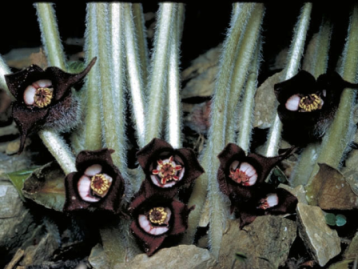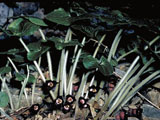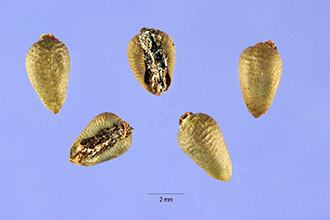"Don't reinvent the wheel, just realign it."
- Anthony J.
 D'Angelo
D'Angelo
The quote above is a great analogy for adaptation. Adaptation is altering the structure or function in an organism so that it is better fitted to survive in its environment. Basically, it is taking the structures present and making them better. Asarum canadense has two main adaptations: one with the flowers and the other with the leaves. The flower of each individual plant is adapted to sit horizontally on the soil surface. This allows for easy pollination via insects, such as ants, beetles, and flies.
As seen in the photo, the leaves of Canadian wild ginger are very large. This plant grows low to the ground and is most successful when in shade, so because of this it does not receive much sunlight. Sunlight is vital for the nutrition of Asarum canadense, and leaves are the main location for photosynthesis to take place. The leaves have adapted to grow much larger in order to obtain as much sunlight as possible.
 Adaptation has also occurred to make
reproduction successful. Asarum canadense is a
perennial plant, meaning that it has a life cycle that lasts
more than two years. The flower of Canadian wild ginger is
a very important structure specialized for sexual reproduction.
Within the petals of the flower there are stamens and carpels.
Stamens produce microspores that later develop into pollen grains
that contain male gametophytes. Carpels produce megaspores, which
produce female gametophytes. The life cycle of Canadian wild
ginger alternates between a gametophyte and sporophyte.
Adaptation has also occurred to make
reproduction successful. Asarum canadense is a
perennial plant, meaning that it has a life cycle that lasts
more than two years. The flower of Canadian wild ginger is
a very important structure specialized for sexual reproduction.
Within the petals of the flower there are stamens and carpels.
Stamens produce microspores that later develop into pollen grains
that contain male gametophytes. Carpels produce megaspores, which
produce female gametophytes. The life cycle of Canadian wild
ginger alternates between a gametophyte and sporophyte.
Reproduction occurs by cross-pollination or self-pollination. Ants, beetles, and flies act as pollinators by transporting the pollen from one flower to the sex organ of another. They have easy access to the flower because of its location on the soil. It is usually the sperm-producing male gametophyte inside the pollen grain that is transported. Canadian wild ginger is hermaphroditic, which means it has male and female organs, so it can self-pollinate when needed. However, cross-pollination allows for genetic variability.
 The
seeds of Asarum canadense are large, ovoid, and wrinkled, as you
can see in the picture. It is very difficult to start the plant
from seed so many gardeners start by means of division. The
blooming period takes place in spring and early summer.
The
seeds of Asarum canadense are large, ovoid, and wrinkled, as you
can see in the picture. It is very difficult to start the plant
from seed so many gardeners start by means of division. The
blooming period takes place in spring and early summer.
Learn how Asarum canadense uses these adaptations for nutrition purposes.